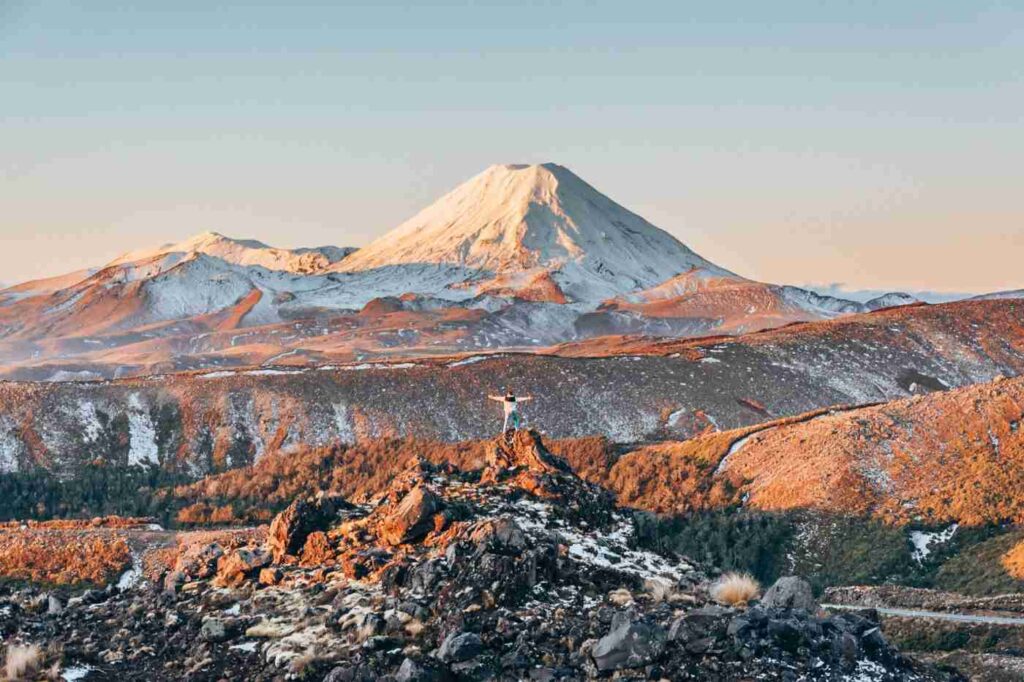Looking for the best places to visit on the North Island of New Zealand in winter? Look no further.
Certain places bring sunny images to mind: blue skies, high temps, warm breezes, and golden beaches. New Zealand fits that bill with stunning landscapes, gorgeous shores, and outdoor fun like hiking, canoeing, and fishing.
Yet, it has a winter too – Kiwi summers aren’t endless. Winter can get chilly and rainy; don’t expect much central heating. Despite the cold, travel remains uncomplicated.
7 Best places to visit north island new zealand in winter
Embrace outdoor adventures, from skiing on Mount Ruapehu to soothing hot springs. Uncover the island’s beauty during the enchanting winter months.
Tongariro National Park

Tongariro, New Zealand’s first national park since 1887, earned UNESCO World Heritage recognition for its cultural importance to the Māori and stunning natural features.
Covering 81,000 hectares, the park displays volcanic marvels like emerald lakes, lava flows, and steaming craters. Its three volcanoes – Ruapehu, Ngauruhoe, and Tongariro – stand at the edge of the Pacific’s ‘Ring of Fire.
These volcanoes, active for two million years, continue to shape the landscape, with Ruapehu last erupting in 1996 and Ngauruhoe in 1975.
Auckland
In Auckland, you get the best of both worlds – the city center and nature’s beauty. Near the city, Waitakere Ranges Park offers over 250 kilometers of rainforest trails, waterfalls, and coasts.
Explore big forests in Hunua Ranges or stunning places like Duder, Shakespear, Tapapakanga, and Awhitu parks. Auckland is surrounded by the sea. Surf on black-sand beaches like Karekare, Piha, and Muriwai.
Find golden shores at Tawharanui, Pakiri. Closer, Mission Bay, Kohimarama, and St Heliers are 15-18 mins from downtown. Walk, kayak, eat by the sea – it’s all there to enjoy.
Natural Hot Spring New Zealand

Situated on the Pacific Ring of Fire, New Zealand sees a lot of tectonic activity. Some places, like Rotorua, are extra geothermal because the Earth’s crust is thinner. Others, like Wellington, feel occasional earthquakes, while Auckland has many volcanoes.
Countrywide, you can discover natural hot springs. In areas with thin crust, underground water warms up and rises as hot water. When mixed with cooler water, it forms these springs. Volcanic underground water also heats reservoirs, providing another type of hot spring.
No matter how the water gets warm, these natural hot springs are rich in minerals and believed to offer health benefits.
Queenstown

Queenstown earns its “adventure capital” title with a bundle of excitement for thrill-seekers. The options for unique and stunning places to visit in Queenstown are endless, offering a blend of stunning sights, delicious food, and outdoor fun.
An adrenaline favorite, Shotover River delivers intense white-water rafting and jet boat cruises. Its steep canyon walls amp up the thrill, featuring larger rapids than nearby rivers.
Just 15 minutes away is Arrow, a town bursting with autumn colors along the Arrow River. Once a gold mining hub, its historic charm adds a unique touch.
For panoramic views, tackle Bob’s Peak, reached through steep trails or a gondola ride. The peak boasts Southern Hemisphere’s steepest cable car and treats you to breathtaking Queenstown vistas. Activities up top make it a must-visit attraction.
Lake Taupo

In New Zealand’s volcanic center, you’ll find Lake Taupo, Australasia’s largest freshwater lake. Its vast, shimmering waters shift from aquamarine to jade, offering clear views down to 14 meters. It’s a hub for wild trout fishing, housing 30+ water bird species, native fish, and crayfish.
Despite its tranquil appearance, Lake Taupo was born from a massive explosion 26,000 years ago, flinging debris high and forming the lake’s caldera.
Activities include fishing, boat tours, water sports, and viewing the impressive Ngātoroirangi Mine Bay Māori Rock Carvings. The Great Lake Trails trace the shoreline as part of New Zealand’s cycle network.
With a sharp drop-off, the lake reaches 176 meters deep, often veiled in morning mist that clears to reveal its sparkling surface. Floating pumice rocks are a common sight.
